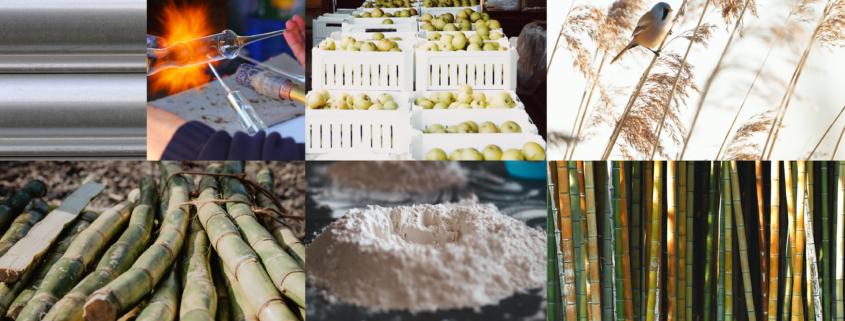Straws for drinks: which materials to choose?
Plastic straws, which have been prohibited in France since January 2021, are composed of polyethylene, which is derived from petroleum. This basic and affordable polymer is nearly non-biodegradable: it takes hundreds of years to degrade into harmful micro-particles, which are little fragments of plastic that are undetectable to the human eye. In a few decades, these microscopic particles have polluted all seas and marine organisms at all levels of the food chain. From one pole to the other, and even deep in the water. Plastic, which is abundantly produced, tends to collect in the environment: more than 10 million tons of plastic end up in the seas and oceans each year, endangering biodiversity. As a result, more environmentally friendly alternatives to plastic straws were required.
This article provides an overview of the materials used in beverage straws and analyzes their environmental effect throughout their life cycle, including disposal.
Drinking straws: natural and unprocessed materials
When there is only one natural raw material and it is not combined with any other product, we refer to it as “unprocessed.” Some raw materials, in fact, do not require any alteration before being utilized in drinking straw. Nature provides them with a natural tube that allows them to be utilized simply as natural straws. Of course, their diameter will not be set, but once cleaned, these natural stems are ideal for sipping your beverages. There are several vegetables and natural stems available, such as wheat, reed, and bamboo. Available in enormous quantities in nature and renewable, you just cut, rinse, and sanitize them to use as drinking straws. Because the material is natural, it is impossible to totally regulate the diameter.
Straws made from natural wheat stems for single-use
Farmers cut the wheat plants during harvest season, keeping only the grains and discarding the stems. As a result, straw is an agricultural byproduct that may be gathered to feed cattle but also utilized to make drinking straws. They are chopped and cleaned to ensure that they are safe for food contact.
As a result, this material is entirely natural; wheat straw is a raw resource. It is also compostable and biodegradable in a short period of time. Despite being constructed of the wheat stalk, the straw is sturdy and does not soften after being soaked in the liquid. Because it is heat-resistant, it may be used for both cold and hot drinks. We choose stalks with a diameter of 4 to 6 mm.
Natural reed straws that are reusable
Reed is a plant whose stems have long been used to make musical instruments, brooms, roofing, basketry, and other items. This substance is natural and is manufactured from raw materials that have not been treated. The reed stems are hollow; we just clip them to produce the length of straw required by the market. We guarantee a diameter range of 5 to 8 mm, depending on the size of the reed stem. Reed stems are tougher than wheat stems, therefore reed straws may be reused up to ten times (we don’t advocate washing them in the dishwasher).
Reusable natural bamboo straws (no fiber)
We make use of a genuine bamboo pole. These hollow poles are frequently rather huge and quite thick. They are not processed but just handled, like wheat and reed straw. Our straws are not composed of bamboo fibers, which are frequently combined with plastic to make straws. The raw substance is just that: raw. Furthermore, bamboo is the most renewable plant due to its rapid growth, making it a sustainable material. Our bamboo straw contributes to a zero-waste strategy since it can be reused an average of 90 times (it can be put in the dishwasher).
Drinking straws: manufactured materials
Other materials are created as a result of the processing of raw materials. Because processed materials are made to best match the demands of straw, they have various advantages over unprocessed materials. However, it is critical to examine the composition of these materials to determine what they truly include, particularly for the novel materials known as “bioplastics.”
Stainless steel, glass and silicone reusable straws
- Our stainless steel straws are constructed of stainless steel. It’s an iron-carbon alloy with chromium added to make it stainless, which means it’s resistant to corrosion and doesn’t rust. As a result, the generated material is exceedingly robust and is employed in a variety of applications. These reusable straws are extremely durable and have an endless lifespan. Don’t be concerned about the metallic taste of your beverages; it has no effect on the flavor.
- Glass straws are constructed of extremely durable glass. They are fairly thick, but not indestructible. In contrast to Borosilicate glass, Soda-lime glass is recyclable. The glass straw is dishwasher safe and may be reused for a long time, resulting in zero waste.
- Finally, silicone is strong and flexible because it is manufactured from silicon, a chemical element found in the earth’s crust in solid or gaseous form. It can have an extraordinarily long life if it is of great quality. This substance is not biodegradable, but it is inert, which means that, unlike plastic, it does not produce any toxins. Our silicone straws are reusable for a long time since the silicone used is of excellent quality and does not crack or damage. The silicone prevents the growth of bacteria both inside and outside the device, which is unique to this material.
Apple pulp and fiber straws are edible
- The combination of Durum wheat Semolina and water is ideal! This substance is perfectly edible; when not in touch with a liquid, it resembles uncooked dough. When submerged in a liquid for around 20 minutes, the paste straw softens and becomes simpler to consume. Because the basic materials utilized are natural, this straw biodegrades swiftly in a compost.
- The apple straw, like the pulp straw, is formed from durum wheat semolina and apple fibers. These fibers are the byproducts of apple juice or cider manufacturing that the firms in issue often discard. We collect these fibers that would otherwise be discarded to make an original and novel material as part of a zero-waste strategy. To make the straw stand-up straight and taste excellent, we also add citric acid, maltodextrin, and sugar. The substance is biodegradable and devoid of plastic.
To conclude, we have decided to suggest the materials that we thought were the most intriguing in terms of quality, durability, a low or non-polluting end of life, raw material origin, and so on. However, there are some materials that we do not recommend, such as paper. Paper decomposes when it comes into touch with a beverage and is difficult to recycle, therefore we no longer include it in our material selection, despite the fact that it is an alternative to plastic.
Please browse our Disposable straws and Reusable straws pages to discover more about our extensive selection of straws.
The straws that we do not recommend, attention:
Disposable straws made from “bagasse” (❌plastic medical field)
It is formed of natural fibers, specifically sugar cane, also known as bagasse. After extracting the juice from bagasse and sugar cane, the fibrous waste is chemically converted into bioplastic. The end product is a polymer derived from natural resources, including organic and plant ingredients. If the straw has a plastic texture, it was most likely chemically converted in a factory with a bioplastic binder to make it biodegrades only in the factory. Because this plastic straw texture is restricted by the current AGEC regulations, be sure it is compatible with your purpose. This plastic straw will be permitted solely in the medical profession.




Leave a Reply
Want to join the discussion?Feel free to contribute!